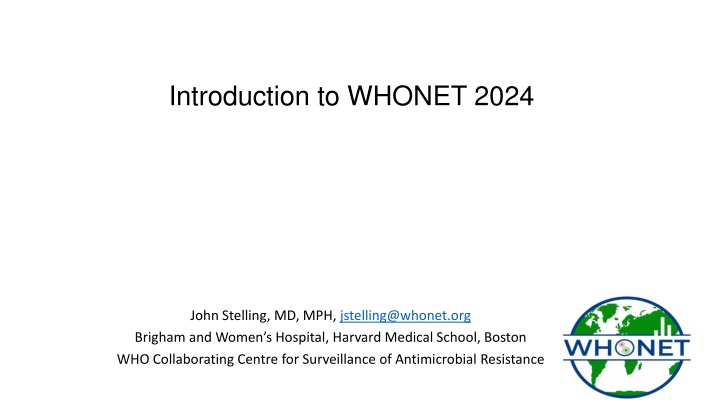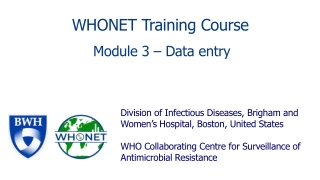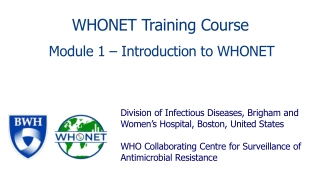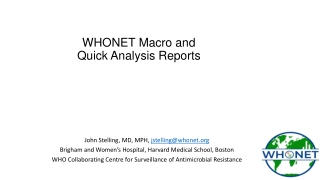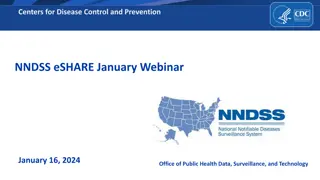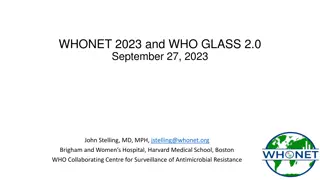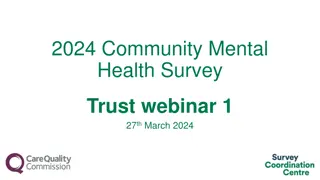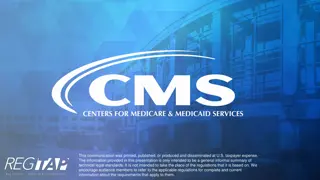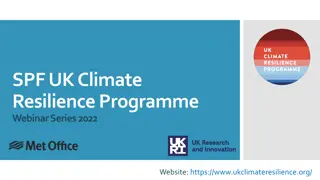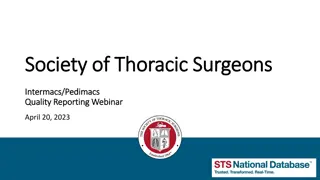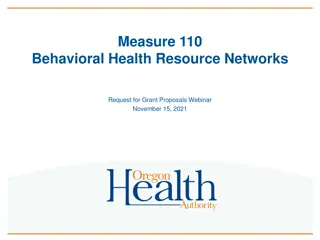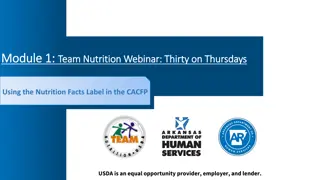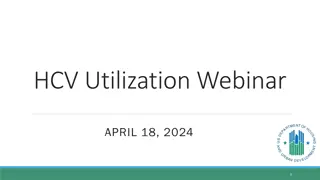Introduction to WHONET 2024
Join Dr. John Stelling for an in-depth look at WHONET 2024, a platform for antimicrobial resistance surveillance. Explore past webinars and future topics, access training materials, and engage in discussions on the WHONET website. Discover the WHONET Training Course with modules covering installation, data entry, analysis, and interpretation. Stay updated on CLSI and EUCAST breakpoints, WHO GLASS modules, and One Health initiatives.
Download Presentation

Please find below an Image/Link to download the presentation.
The content on the website is provided AS IS for your information and personal use only. It may not be sold, licensed, or shared on other websites without obtaining consent from the author.If you encounter any issues during the download, it is possible that the publisher has removed the file from their server.
You are allowed to download the files provided on this website for personal or commercial use, subject to the condition that they are used lawfully. All files are the property of their respective owners.
The content on the website is provided AS IS for your information and personal use only. It may not be sold, licensed, or shared on other websites without obtaining consent from the author.
E N D
Presentation Transcript
Introduction to WHONET 2024 John Stelling, MD, MPH, jstelling@whonet.org Brigham and Women s Hospital, Harvard Medical School, Boston WHO Collaborating Centre for Surveillance of Antimicrobial Resistance
WHONET Webinar series You can find the videos for past webinars on the WHONET Home Page, click on Webinars . The audio is available in English. The subtitles are available in approximately 20 languages. Past webinars September WHONET and WHO GLASS 2.0 October WHONET macros and reports November WHONET and multidrug resistance January WHONET-SaTScan and cluster/outbreak detection, Part 1 March WHONET-SaTScan and cluster/outbreak detection, Part 2 Today s webinar WHONET 2024 Introduction Possible ideas for future webinars Annual antibiograms and CLSI M39 WHONET DHIS2-AMR module WHONET Automation Tool WHONET AST interpretation engine WHONET Discussion Forum One Health features: WHONET, FAO, and InFARM Country-, region-, and/or language-specific sessions Welcome to suggest ideas for future webinars! help@whonet.org
Webinar agenda WHONET Website WHONET 2024 materials Online WHONET Training Course WHONET Discussion Forum CLSI and EUCAST breakpoint updates o WHONET interpretation categories o WHONET Test Interpretation Engine WHO GLASS modules Animal Health and One Health modules
Part 1: WHONET Website WHONET 2024 materials WHONET Training Course WHONET Discussion Form
WHONET 2024 Materials Website review
WHONET Training Course The course materials can be found at: www.whonet.org/training.html The course consists of six modules (eventually seven) Module 1: Introduction and installation Module 2: Laboratory configuration Module 3: Data entry Module 4: Introduction to data analysis Module 5: Data analysis and interpretation (this will be split into Part 1 and Part 2) Module 6: Quick analysis and standard reports The course includes PowerPoint YouTube presentation, exercises, exams, and course completion certification
WHONET Training Course Hosting platform The course is currently hosted on the WHONET website The original goal was to have the course hosted on the OpenWHO platform, www.openwho.org However, as of January 2025, the OpenWHO platform will focus on training for emergency and epidemic needs. The OpenWHO platform is managed from WHO Headquarters in Geneva The new goal is to collaborate with the WHO Learning Academy, www.who.int/about/who-academy The WHO Academy is the World Health Organization s institute for learning. Our learning platform leverages machine learning and artificial intelligence to provide an engaging and personalised experience for every learner. The WHO Academy will open to all learners in December 2024, both online and at our new campus in Lyon. We anticipate that an adapted version of the course will be hosted with FAO Probably FAO Virtual Learning Centres, virtual-learning-center.fao.org FAO also hosts the FAO eLearning Academy, elearning.fao.org
WHONET Training Course Demonstration
WHONET Discussion Forum Demonstration
Part 2: CLSI and EUCAST breakpoint updates WHONET interpretation categories WHONET Test Interpretation Engine
WHONET Interpretation categories R = Resistant I definitions CLSI Intermediate EUCAST Susceptible with Increased exposure S = Susceptible SDD (CLSI only) : Susceptible, Dose-dependent comparable to EUCAST I category NS (CLSI only): Not susceptible (when there is no defined R category) WT: Wild type according to Epidemiological Cutoff Values (ECOFFs / ECVs) NWT: Non-Wild type ?: No interpretation is possible. There are no published breakpoints
Categories R?, I?, S?, NS?, and SDD? These are utilized only for off-scale MIC values that do not align with the currently published breakpoint. Example If the susceptible breakpoint is S 1, then an MIC equal to 0.5 or 1 is clearly susceptible. And MIC recorded as 1 is also clearly susceptible However, if there is an MIC recorded as 4 , then it we cannot say with certainty that the isolate is susceptible. This may happen infrequently because of a simple typing mistake. Perhaps the user intended to write MIC 4. However, more frequently it reflects a change in the published breakpoints. For example, an imipenem MIC 4 was considered to be susceptible until 2010 when CLSI changed the breakpoint to MIC 1. WHONET will assign an interpretation category of S? because the symbol suggests that the isolate is as susceptible as the test would permit, but a ? because it is possible that the interpretation might not be S . Most commonly S? will mean Susceptible by the older breakpoints probably susceptible by the newer breakpoints, but we cannot be certain .
WHONET Interpretations Demonstration
WHONET AST Interpretation Engine Old WHONET interpretation approach Use of General breakpoints Mixture of external data tables and internal hard-coded rules, especially for Complicated organism hierarches Multiple breakpoints (meningitis, nonmeningitis, uncomplicated UTI, horses, fish, etc.) Default methods from WHONET 1989 through WHONET 2023 New WHONET interpretation approach There are no longer general breakpoints Use of CLSI and EUCAST Intrinsic resistance tables Everything is now data driven Easier maintenance for the WHONET team Use of our tables by other groups (MSF Mini-LIMS, Viet Nam web portals, Bhutan LIS, being explored by others) Discussions in collaboration with WHO, CLSI, EUCAST, MSF, Wellcome, and others Default for WHONET 2024 for new configurations that you create. For existing configurations, WHONET continues to use the old approach unless you request to switch to the new approach.
Part 3: WHO GLASS modules WHO GLASS-AMR WHO GLASS-EGASP WHO GLASS-FUNGI WHO GLASS-BACTERIA WHO ESBL Escherichia coli TriCycle project
WHO GLASS Modules GLASS- BACTERIA
WHO GLASS Modules Demonstration
Part 4: One Health modules and features FAO InFARM (Global) FAO AMR Surveillance protocols (Asia-Pacific) GISSA SILAB
FAO InFARM InFARM = International FAO Resistance Monitoring www.fao.org/antimicrobial-resistance/resources/infarm-system Two options for reporting Model A: Individual-level reporting, including (ideally) disk diffusion zone diameters and MIC values Model B: Annual aggregate reporting on a broad range of animal, specimen, organism, and antibiotic combinations Regional training workshops Americas: Bogota, Colombia: July 2-4, 2024 Africa: Lusaka, Zambia: July 15-18, 2024 Asia: Bangkok, Thailand:
AMR surveillance protocols FAO Region of Asia and the Pacific Protocols https://www.fao.org/antimicrobial-resistance/projects/completed/project-3 Volume 1: Monitoring and surveillance of AMR in bacteria from healthy animals intended for consumption Volume 2: Monitoring and surveillance of AMR in bacterial pathogens from diseased livestock and poultry Volume 3: Monitoring and surveillance of AMR in aquaculture Volume 4: Monitoring and surveillance of AMR in animal environment Volume 5: Monitoring antimicrobial use at the farm level (Volume 6: Monitoring of antimicrobial residues)
GISSA - Global Integrated Surveillance System for Antimicrobial Resistance and Antimicrobial Usage Integrated surveillance of antimicrobial resistance and use: An expert Quadripartite technical group on integrated surveillance established by the QJS in 2022 has developed and agreed on an action plan for 2022- 2024 to develop a list of priority outputs, including a Quadripartite guide on integrated surveillance along the One Health spectrum, which is near finalisation. The Global Integrated Surveillance System on Antimicrobial Resistance and Use (GISSA), now in development, aims to serve as a repository pooling data collected from across sectors by the Quadripartite organizations. From the February 2024 The Quadripartite Joint Secretariat on AMR Progress Report Primary data resources: WHO GLASS in 2023, 137 countries enrolled and 91 countries reporting AMR data FAO InFARM going live now (June? July?) WOAH ANIMUSE World Organization for Animal Health Animal antimicrobial USE, amu.woah.org/amu-system-portal UN Sustainable Development Goals on AMR (drawn from WHO GLASS statistics) From the Quadripartite Key Recommendations and Priorities for the 2024 UNGA High-Level Meeting on Antimicrobial Resistance (AMR) WHO GLASS and . The FAO InFARM (International FAO Antimicrobial Resistance Monitoring) and WOAH ANIMUSE (for ANImal antiMicrobial USE) databases have enabled AMR surveillance in agrifood system, and AMU surveillance in animals and are supporting the development of an integrated AMR surveillance system (Global Integrated Surveillance System for AMR, GISSA). The inclusion of new AMR indicators in the SDG monitoring framework and the publication of a Quadripartite One Health priority research agenda for AMR and the WHO global research agenda for AMR in human health are also important steps forward to catalyze action on prioritized areas.
SILAB Animal health laboratory information system Useful links Home page: www.izs.it/IZS/Cooperation/IZSAM_and_Africa/SILAB_for_Africa_Project Publication: pubmed.ncbi.nlm.nih.gov/30767711
WHONET One Health modules Demonstration
